Yoga has evolved in many ways in modern times. One of the most fun and perhaps challenging ways yoga has evolved has been toward trio Acro yoga.
Trio Acro yoga involves poses where one or more yogis are raised in the air, blurring the lines between yoga and acrobatics. These 3 person yoga poses are creative and challenging – requiring a big dose of balance, trust and focus from yogis involved.
And don’t worry, we’ve put together a list of three-person yoga poses accessible for the most beginner of yogis, to the most advanced, sure-fired to boost your self-esteem and leave you pumped with happy endorphins.
P.S – Don’t forget your camera!

What is Acro Yoga?
Acro yoga is the best described as a playful blend of yoga, acrobatics, and gymnastics. This form of exercise is definitely unique but offers a host of benefits; huge potential for fun; as well as a sense of achievement, giving rise to its recent popularity.
Essentially, you will work with your fellow yogis to learn to lift one another and be lifted, and so Acro yoga will truly test your balance, communication, and teamwork as you use your body in harmony with your fellow yogis, bringing newfound levels of trust to whoever you choose to practice with.
Jenny Sauer-Klein and Jason Nemer started Acro yoga in the USA in 2003 (you can check their website out here).
Benefits of 3-Person Yoga Poses
Communication:
One-way Acro yoga outperforms an individual yoga practice is through its demand for clear communication and trust between yogis. Communication is the cornerstone of a successfully executed 3-person yoga pose – without it, the poses would not be possible. You must also be able to put your trust in your fellow yogis as you work together to balance each other’s bodies.
These skills can also benefit you off the mat too – improving your communication skills, as well as deepening your relationship with the people you practice with.
Bonding:
Three-person yoga provides a unique way to bond and has the potential to open up new friendships in your life, as well as strengthen your relationships. With your fellow yogis, you will support one another physically and mentally, as well as have a ton of fun. Three-person Acro Yoga is also a great idea for parents and children – giving time for you to bond as a family, as well as boost your child’s confidence and trust skills.
Flexibility:
Acro yoga can support your body to feel into and reach a much deeper stretch than in your regular practice, stretching you out in the moment, but also improving flexibility long term. Additionally, Acro yoga creates spinal decompression via inversions, which can improve back pain, as well as stimulate circulation.
Strength:
Be prepared, as three-person Acro yoga will demand more strength from you than your standard yoga practice. Throughout the practice, as you support both your own and your fellow yogi’s body weight, you will need to ensure your muscles are engaged and stabilized (get ready to break a sweat!). This practice will help you to build extra muscle and tone over time (psst, you might even be able to cancel that gym membership).
Acro Yoga Basics: the 3 Key Positions
- The Base: This yogi is usually supporting the pose from the bottom with strength and stability. The base yogi is the foundation of the pose, and so this role requires confidence and strength.
- The Flyer/s: This yogi or yogi’s (three-person Acro yoga can include two flyers to create unique and challenging shapes) role is engaging their balance, coordination, and bodily control to be up in the air, balancing on the base’s limbs.
- The spotter: This role is integral to Acro yoga’s safety. The spotter watches all yogi’s forms, ensuring nobody falls and supporting them where necessary. If you are a beginner, we recommend having a spotter to help you feel safer and thus, more confident in your practice.
First Things First, Let’s Warm-up!
Before jumping headfirst into Acro yoga, it’s imperative to warm up, plan and practice. If you skip these important steps, you may be putting yourself at risk for injury. Acro yoga is a fun, playful practice, but it also involves balancing in the air on other people’s bodies. Safety must come first!
We recommend starting with some gentle yoga postures; prioritizing relaxation, feeling grounded, and stretching out the body. Try the below three-person poses to start your practice off on the right foot; by feeling connected with your fellow yogis and tuning into each other’s bodies.
Triple Forward Fold
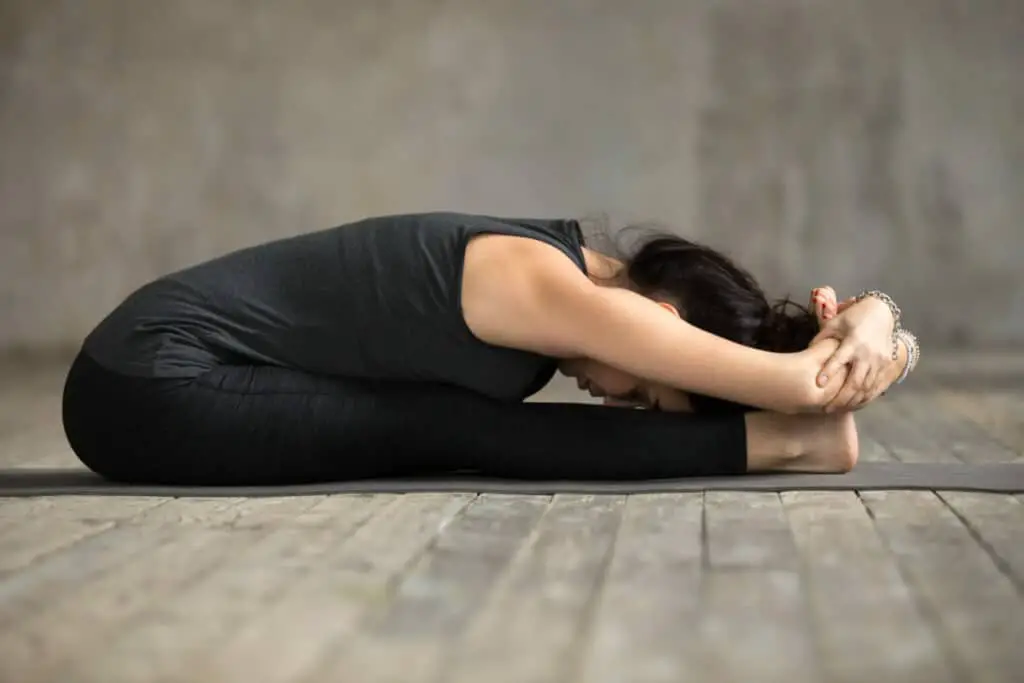
Sitting in a three-point circle, each yogi extend your legs with the tips of your toes touching. Inhaling deeply, lengthen your spines toward the sky, and fold forward from the hips. Interlock your hands and work together to deepen the stretch and practice communication about how your bodies feel and what you need in the pose.
Back-to-Back Lotus
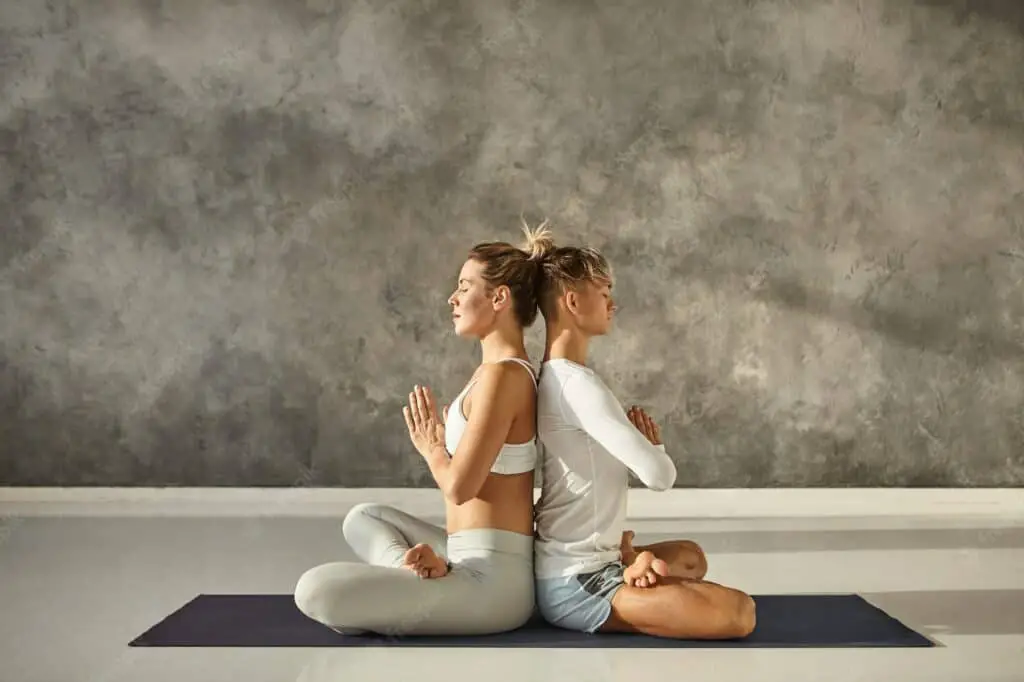
Start by sitting in a three-point back-to-back circle, facing outwards with your backs touching. Altogether, take 5 deep breaths, breathing in through the nose and down into the stomach, and exhaling slowly, in unison, through the mouth. Use this time to synchronize your bodies via the breath for a more connected and trusting Acro practice. To optimize this, you may sigh the breath out of the mouth, vocalizing together, to get comfortable using your voices.
Beginner Yoga Poses for Three People
1. Warrior lll for Three People
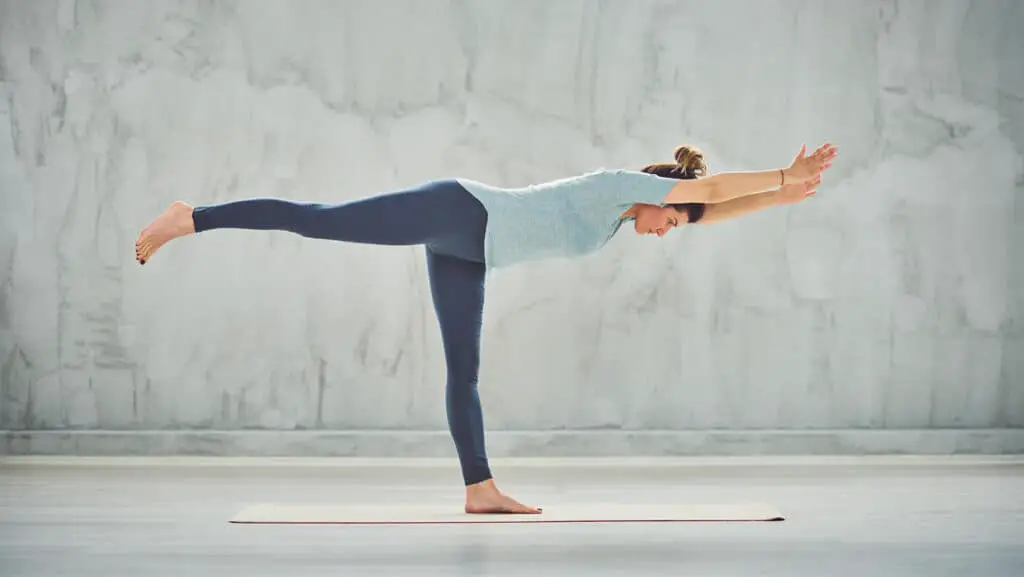
Take the classic warrior pose, times it by three, and you’ve got a beautiful trio of beginner warriors.
- All yogis stand in a circle, facing each other. Inhale the arms overhead, and as you exhale, allow your left foot to take flight, leaving your right food as a strong base.
- All yogis can bring their hands to contact or interlock while hinging at the waist and flexing the left foot, with the eyes fixed in a direct line to the floor.
- Breathe together here and when you are ready, practice the process again on the opposite side.
2. 3-way Lord of the Dance Pose
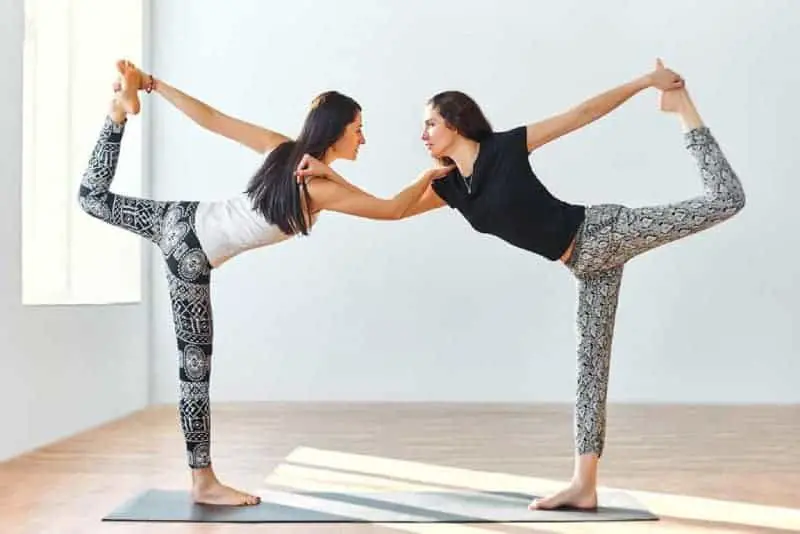
Similar to Triple warrior lll, each yogi will support another in finding the lord of the dance pose, mirroring one another and synchronizing the breath.
- Begin in a circle, facing one another.
- Move your weight into the right leg, bending the left leg at the knee and clasping the inside of the left ankle with your hand.
- Slowly extend from the left glute, lifting the left ankle into the air and hinging at the hips.
- Once all yogis have found their Lord of the Dance pose, you can reach your arms forward to clasp hands or shoulders in the middle of the circle.
- Hold the posture, and follow the same process on the other side.
3. 3 Person Ballet Pose
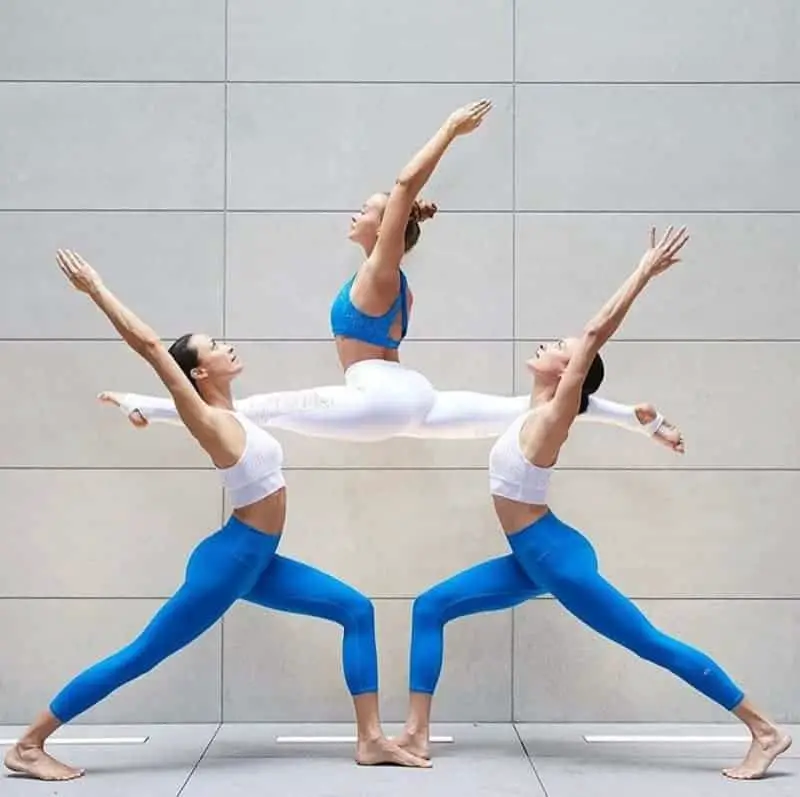
This pose will require a flyer that can sit comfortably in front splits, along with two strong warrior bases.
- To start, the two base yogis can find their Warrior 1 position, ensuring their front toes are aligned with the opposite base yogi’s heel, hips parallel to each other.
- The flying yogi can then step onto each of the base’s thighs, facing one base and lifting their front leg onto this bases shoulder. The front base and flyer can hold hands whilst getting into position for support.
- The opposite base can then support the flying yogi’s back leg into the position of front splits. The flyers’ shins should be balancing evenly on each of the base’s back shoulders.
4. 2-Person Whale Pose with a Spotter
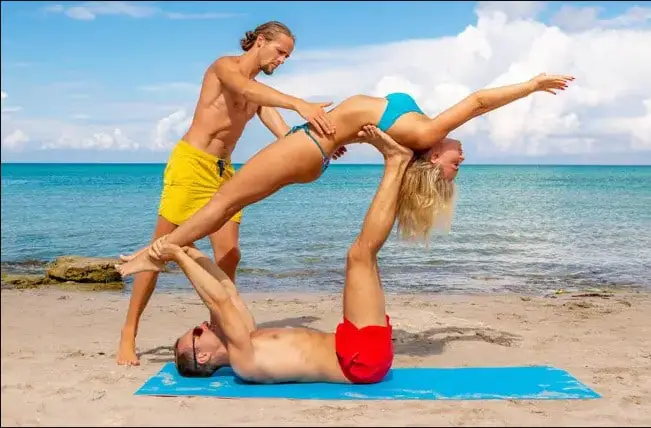
This pose requires one yogi base, one flyer, and one spotter.
- To start, the base yogi can lie on their back, ensuring the lower back is pressed firmly into the ground. Extending the legs to 90 degrees above the hips, the base yogi can bend their knees to prepare for the flyer balance.
- The flying yogi stands at the crown of the base’s head, facing away from them. The base yogi grabs the flyer’s ankles firmly. The flyer leans back, and the base yogi moves their feet to rest under the flyer’s shoulders, heels pressing into the top of the shoulders and toes at the bottom of the flyer’s shoulder blades.
- The flying yogi can then extend their arms, and lean further into the pose as the base yogi lifts the flyer from the ankles.
- The spotter is present to ensure no one falls, levitating their hands near the flyer’s waist for safety.
5. L-Shape Downward Dog

This pose requires one base and two flyers, comfortable with being upside down, almost in supported L-shape handstands.
- Start with the base finding their downward-facing dog, ensuring they feel strong and ready to begin supporting their fellow yogis.
- Next, the first flyer can place their hand just over a hips-width distance on the mat, in front of the base’s hands. Slowly bringing each leg up, resting their ankles on the base’s lower back and pointing the toes to form a half-downward facing dog.
- The second flyer can then follow this same process, finding a full L-shape assisted handstand.
Intermediate Yoga Poses for Three People
6. Trio Plank Pose
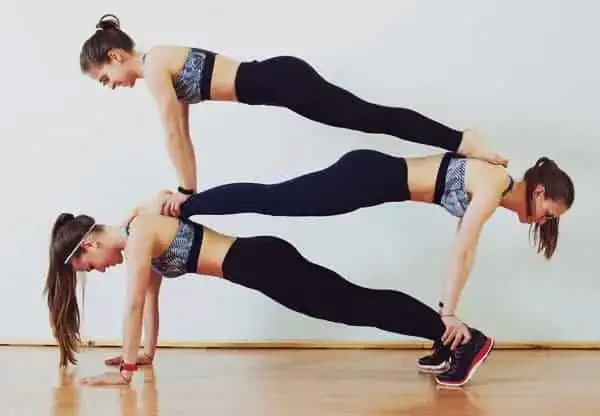
This pose requires one strong, active base, and two flyers. Before attempting this posture as a trio, be sure you can confidently hold a solo plank pose.
- Start with the base yogi getting into their plank pose and feeling stable with regulated breath.
- The first flyer will begin by placing their hands on the base’s ankles and looping their fingers around them for support. They can then place each foot flat onto the base’s shoulders.
- Once the first flyer feels stable, the second flyer can then follow the same process as above, in the opposite direction.
7. Goddess Trio

This pose requires two base goddesses and one flying goddess.
- Two bases stand parallel in their goddess pose, ensuring their knees are tracking their toes and that their core is tight with the pelvis tucked.
- The flyer then can climb up into goddess pose, using the base’s thighs as the foundation, placing one foot on each base’s upper thigh, close to their hips.
- The flyer can hold one of each base’s hands for support and balance.
8. Laying Trio
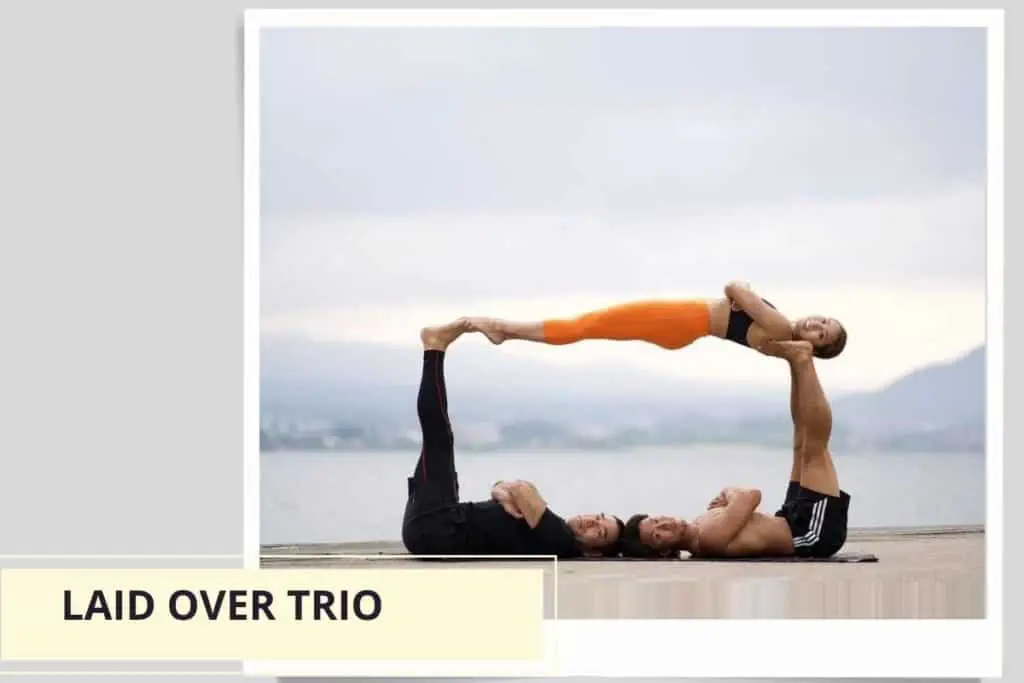
This pose requires two bases and one flyer.
- Both bases can lie on their backs with the crown of their heads touching, hips facing opposite directions. Each base can then extend its legs upwards and flex the feet.
- Once feeling strong and stable, the bases can bend their knees for the flyer to get into position.
- The flyer can press their shoulder blades into one of the base’s feet, ensuring the neck feels supported. Engaging the core, the flyer can then extend one leg at a time, hooking their toes into the opposite base’s toes.
- The bases can then extend their legs to stretch the flyer out into a straight, vertical line.
9. Split Down Dog Trio

This pose requires two bases and one flyer, involving the bases finding a split downward dog position, and the flyer balancing in an extended mountain pose.
- The two bases get into downward dogs, facing each other with their shoulders around a hips-width distance apart. Each base can then lift their left legs into a split downward-facing dog with pointed toes.
- The flyer can carefully climb onto the bases by holding each base’s ankle and placing one foot on each of the base’s shoulders.
- The flyer should ensure to distribute their weight evenly between each foot and fix their gaze straight ahead for balance.
10. Back Bend Trio
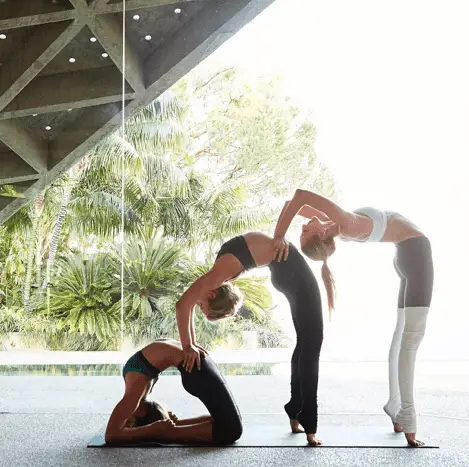
This pose requires one base and two flyers. All three yogi’s must be warmed up and comfortable in holding wheel pose. We recommend warming up with camel pose and cooling off with child’s pose afterward.
- First, the base can find their wheel pose and let the first flyer know when they are ready.
- The first flyer then stands around a hips-width distance away from the base’s knees, and flows back into their wheel, placing their hands on the base’s hips.
- The second flyer can then follow the same process as above, finding a slightly less extended wheel attached to the first flyer’s hips.
11. Downward dog tower
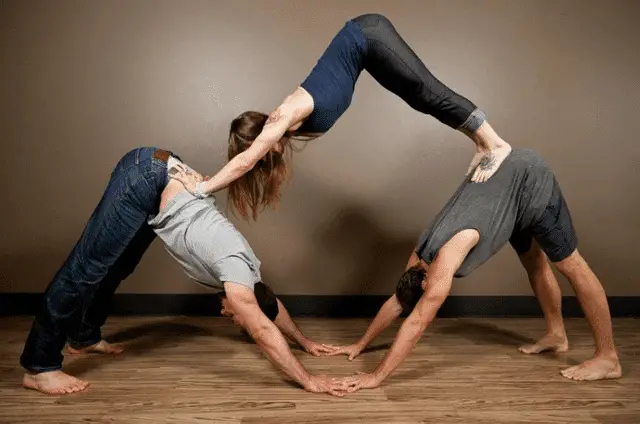
Two yogis will act as a base, and one as a flyer. This pose requires balancing skills and breath unison for each yogi to perform downward facing dog in a pyramid.
- Start with two yogis in stable downward-facing dogs, ensuring hands and heads are an appropriate distance from each other.
- The flyer then carefully places their palms on the upper backsides of the first base, followed by bringing the feet on the upper buttocks of the second base
- Synchronize breathing and balance together to see how long you can hold this pose.
12. Three-person throne pose
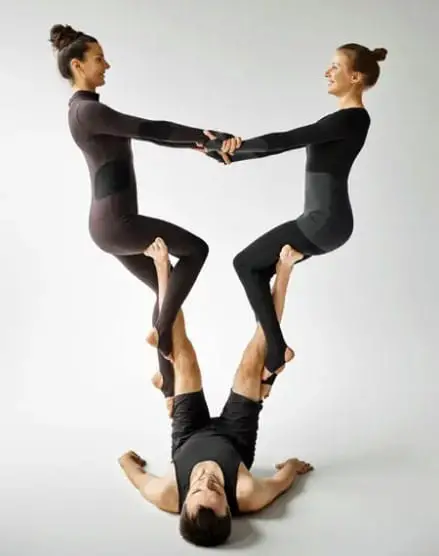
One yogi will act as the base, and two yogis as the flyers.
- Start with the base yogi lying on their back with a tight core, lower back pressed into the floor. Raise two legs parallel with the hips, arms spread out and palms pressed into the floor. Bend the knees slightly to create the right height for the flyers to get into the posture.
- Each flyer can then sit one thigh onto the sole of one of the base’s feet. Flyers can grab each other’s wrists with their hands for stability, and wrap their calf around the base’s shin, secured with their toes behind the base’s knee.
- Each flyer can then use their other leg for stability, pushing into the base’s calf and squeezing the front of their feet into the base’s outer thigh.
- The flyers should pull into each other’s hands and tighten their cores for balance.
Advanced Yoga Poses for Three People
13. Trio Flying Mountain and Throne Pose
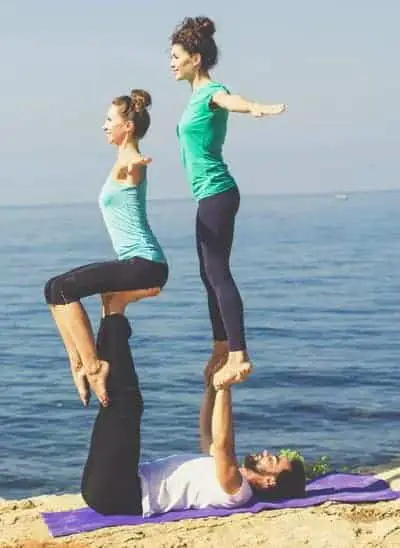
This pose requires one stable base and two balanced flyers. The flyers will not be touching one another for balance, and so need to feel confident holding their own shape in this posture, trusting their base below them.
- To start, the base yogi can lie on their back, lower back pushed firmly into the ground.
- The first flyer will stand facing away from the base. The base can then place their feet on the flyer’s sit bones and with bent knees slowly extend to press them up into a seated throne pose.
- Once the first flyer is feeling stable, the second flyer can then enter the pose. The second flyer can slowly step onto the base’s extended arms, placing one foot in each of the base’s hands. The base should grip their fingers around the flyer’s feet, ensuring their palm is pressing into the base of the flyer’s feet.
- The second flying yogi will need to be fully extended, ensuring all their muscles are engaged to achieve balance here.
14. Double Plank Press
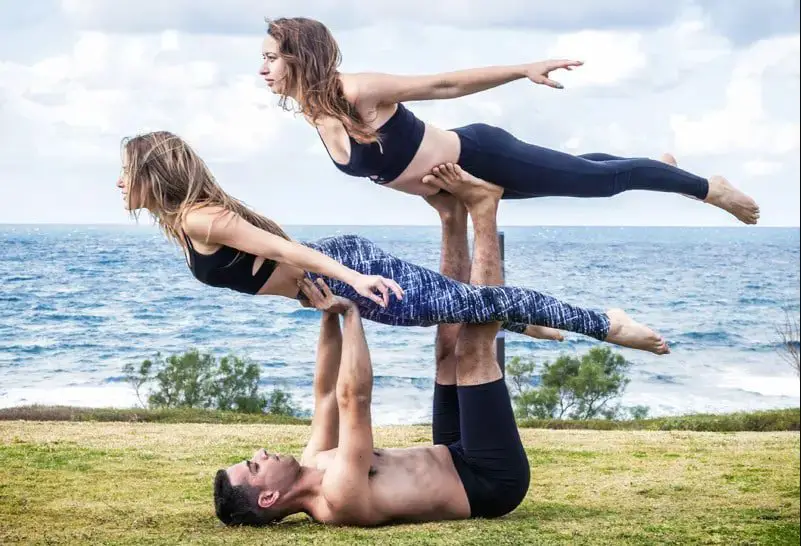
This pose requires a strong base and two flyers. Think of a traditional Acro yoga plank press and times it by two. One flyer will be balanced on the base’s arms, and the other on their feet.
- To start, the base yogi can lay flat on their back, starting with the feet on the floor.
- The first flyer can stand over the base yogi, with one foot on either side of the base’s hips.
- The base yogi can then secure their hands into the flyer’s hips, with palms pushing into the flyers hip bones and fingers and toes extending toward the flyer’s waist. The first flyer can slowly lean into the base’s hands, engage the core and find lift. This flyers legs should be split – with enough room for the base’s legs to extend between.
- The second flyer can then follow this same process, only with the base’s feet. Both flyers can find a point to gaze at ahead for balance, and the base’s eyes can stay fixed on both flyers.
15. Double Front Plank
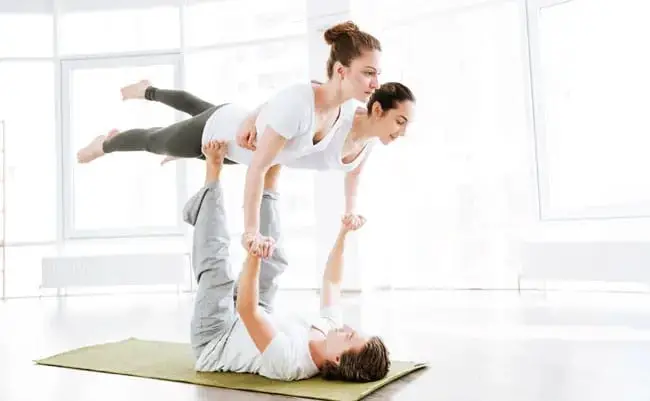
This is a challenging pose requiring one strong base and two confident flyers.
- Start with the base yogi laying on their back, ensuring the lower back is pressed firmly into the ground with bent knees and flexed feet.
- Each flyer can stand near the base’s hips, taking one leg each and preparing to fly.
- The flyers can come close together, wrapping one of their arms around their fellow flyer’s back and securing it with a tight grip at each other’s waist.
- The base yogi can then place each of their feet on the outside hip of each flyer, pressing the heel into the flyer’s groins’ and gripping the toes to the outside waist.
- From here, with their free hands, the flyers can interlock each hand with the base’s hands and begin slowly leaning forward and pressing into double flying plank.
- Both flyers need to be pushing into the hands of the base, and the base pushing upward into the hands of the flyers.
16. Three-Person Flying Plank Press
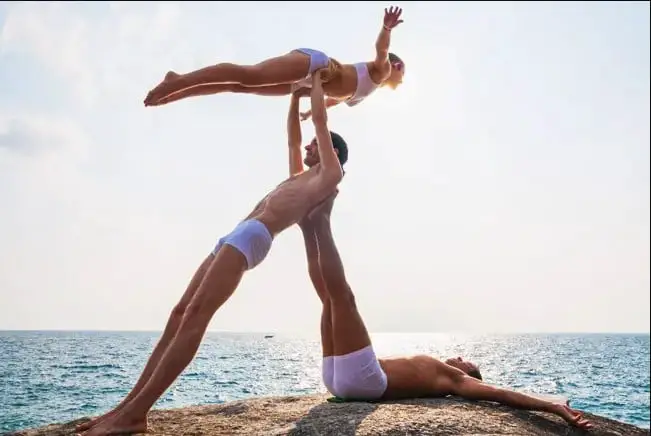
This pose requires one flyer, one base, and one yogi blurring the lines between flyer and base.
- To start, the base yogi can lie on their back, lower back pushing into the ground and arms extended with palms pushing into the floor for extra stability.
- The middle yogi can stand around a leg’s width distance in front of the base’s hips, facing away from them. The base yogi can then extend their legs to place their feet along the middle yogi’s shoulders, the heels of feet pressing into the middle yogi’s upper back. From here, the middle yogi can lean backward, extended into the pose.
- The base’s knees can then bend to lower the middle yogi down to a suitable height for the flying yogi to get into position.
- Standing over the middle yogi, with one foot on either side of the middle yogi’s hips, the flyer can lean their hips into the middle yogi’s hands, palms pressed into hips, and fingers wrapping around the waist. The middle yogi can then extend their arms to support the flyer into a full plank press.
- Slowly, the base can then extend their legs to full extension, supporting the middle yogi to be in a diagonal extension of mountain pose.
17. Flying Downward Dog

This pose requires two strong bases and one brave flyer.
- Both base yogis can start crouched to the ground, with enough room between them for their flying yogi’s downward dog.
- The flyer can take downward facing dog position between the bases. Slowly, one limb at a time, the flying yogi can attach to the base. So, first, the hands are interlinked with one base’s hands. The base yogi can now lift one foot at a time, pressing their palms into the flyer’s feet and wrapping their fingers around the tops of the feet.
- Once stable, the bases slowly extend their legs, followed by their arms, raising the flyer into the air.
18. Flying Handstand

This pose requires two bases and one flying yogi who is confident in handstand.
- To start, both base yogis can find their easy seat (cross-legged position) facing one another. One base can then place their hands on the opposite base’s shoulders with extended arms, pressing the hands into the front of the base’s shoulders to create a strong line of support for the flyer.
- The flyer can then find their way into a handstand by standing between the two bases in a forward fold position.
- The other base yogi can press their hands into the back of the flyer’s shoulders, palms on the top of the shoulders, and fingers pointing vertically down the flyers shoulder blades.
- The flying yogi can lean their weight into the base’s hands, and place their hands onto the opposite base’s shoulders/upper arms. Slowly, the flying yogi can pike press into a handstand.
Summary
For some more inspiration on what you and your fellow yogis could achieve in your Acro yoga practice, check-out one of our favourite videos here!
For a successful 3 person yoga pose practice, we recommend bringing an open mind and plenty of laughter.
Acro yoga is challenging – at times you might feel frustrated and confused. However, it can be extremely rewarding, so don’t give up! There is no better feeling than seeing a challenging pose, and eventually nailing it as a team. The most important thing is to have fun!
More funny Acro yoga pose with 4 people for you.

